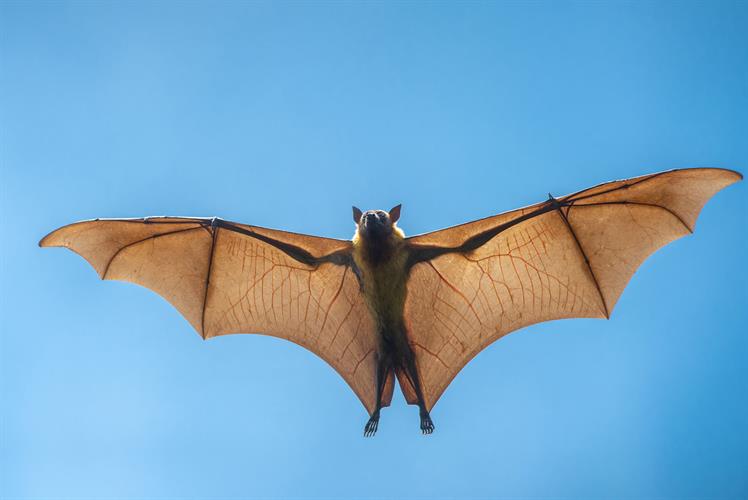July 10, 2020 -- Bats' longevity and capacity to tolerate viruses may stem from their ability to control inflammation, according to a review article published in Cell Metabolism on July 7. The unique mechanisms that bats employ to achieve this may hold clues to developing new treatments for human diseases.
Many bats live in large colonies, which promotes transmission of viruses and other pathogens. Bats are believed to be ancestral hosts for many deadly human diseases including rabies, Ebola, Marburg, Nipah, and Hendra viruses. Bats also consume mosquitoes that spread human diseases.
Now, recent coronaviruses including SARS-CoV, MERS-CoV, and SARS-CoV-2 are believed to have originated in bats or were transmitted by bats to other species and then passed to humans.
Interestingly, these viruses are well-tolerated by bats and do not cause any clinical symptoms. So, University of Rochester researchers wanted to know what biological mechanisms make bats able to tolerate pathogens and spread them to humans.
How are bats immune to viruses?
Bats have a robust interferon response to RNA viruses. For instance, bats express interferon alpha, which would lead to widespread inflammation in other mammals. But in bats, the inflammasome -- a multiprotein intracellular complex that detects pathogenic microorganisms and stressors and activates pro-inflammatory cytokine release -- is significantly dampened.
Whole genome sequencing showed several genes involved in innate immunity were under positive selection, including those that could reduce viral replication. Moreover, there are entire gene families (for example, PYHIN) that are missing in several bat species that could result in dampened DNA sensing.
Also, analysis of 30 bat species revealed that the S358 residue of the stimulator of interferon genes (STING) protein, which is conserved in all other nonbat mammalian species, is missing, leading to a weakened interferon response. Other studies showed that activation of toll-like receptor 9 (TLR9), which recognizes pathogen-associated molecular patterns originating from pathogens, is also reduced.
Overall, bat immunity studies indicated that most immune system adaptations work to dampen the immune response rather than activate it.
Why did bats acquire the ability to tolerate diseases?
One reason that bats may have developed efficient immunity to viruses is due to flight. Bats are the only flying mammals and as such they require certain metabolic adaptions that might improve their ability to handle molecular damage and significantly downregulate inflammatory pathways.

More likely, the driving force in the evolution of bat immunity has been their lifestyle, living in colonies, which leads to rapid transmission of viruses. The authors speculated that high exposure to viral pathogens forced bats to develop ways to coexist with viruses rather than fight them.
"Bats are constantly exposed to viruses," said Andrei Seluanov, PhD, professor of biology at the University of Rochester, in a statement. "They are always flying out and bringing back something new to the cave or nest, and they transfer the virus because they live in such close proximity to each other."
"Usually the strongest driver of new traits in evolution is an arms race with pathogens," said Vera Gorbunova, PhD, the Doris Johns Cherry Professor of Biology at the University of Rochester. "Dealing with all of these viruses may be shaping bats' immunity and longevity."
Could inflammation be the key to bat immunity?
In general, a species' maximum lifespan correlates positively with body mass. However, bats fall below the regression line for mammals as they live longer than other mammals of similar size, up to 30 to 40 years, in some cases.
As bats age, they avoid upregulation of genes involved in chronic inflammation, which is different than many other mammalian species. This may be an attempt to reduce inflammation due to viral infections. But the lack of age-related inflammation may be linked to the longevity of bats. Moreover, the bat's ability for improved mitochondrial maintenance and dampened cytoplasmic DNA-sensing may protect it from age-related inflammation.
Inflammation is the hallmark of the aging process, and of age-related diseases like cancer, Alzheimer's disease, and cardiovascular disease. But viral infection, including SARS-CoV-2, can cause similar inflammation, according to the authors.
"With COVID-19, the inflammation goes haywire, and it may be the inflammatory response that is killing the patient, more so than the virus itself," explained Gorbunova. "The human immune system works like that: once we get infected, our body sounds an alarm and we develop a fever and inflammation. The goal is to kill the virus and fight infection, but it can also be a detrimental response as our bodies overreact to the threat."
This is not the case for bats.
While there have been independent studies on the longevity of bats and on bat immunity, there has been no research tying the two concepts together. Both researchers are experts in longevity and disease resistance. They realized that there may be a strong connection between bats' resistance to infectious diseases and their longevity.
Can humans develop the same tolerance?
Evolution happens over thousands of years. The authors noted that it is only in recent history that humans have started living in such close proximity and that technology has enabled them to travel around the world. Humans have not yet developed the same mechanisms to combat viruses as they emerge and quickly spread.
It would take an unacceptable amount of time for humans to naturally evolve adaptations similar to those of bats that would allow for tolerance and longevity. However, pharmacological interventions might be developed to bring bat-like interventions to humans in a much shorter timeframe. Some of these interventions may include:
- Anti-tumor-necrosis factor (TNF) therapeutics
- NLRP3 inhibitors
- STING inhibitors
- cGAS inhibitors
- Targeted PYHIN gene therapies
The authors suggested that bats coexist with viruses, to control inflammation and subsequent inflammatory cytokine storm, which exacerbates disease leading to mortality. Regarding COVID-19, the researchers acknowledged that aging plays an adverse role in the severity of the disease.
"COVID-19 has such a different pathogenesis in older people," noted Gorbunova. "Age is one of the most critical factors between living and dying. We have to treat aging as a whole process instead of just treating individual symptoms."
The research duo hopes to start a new program at the University of Rochester with the goal of developing drugs that inhibit genes involved in inflammation.
"Humans have two possible strategies if we want to prevent inflammation, live longer, and avoid the deadly effects of diseases like COVID-19," said Gorbunova. "One would be to not be exposed to any viruses, but that's not practical. The second would be to regulate our immune system more like a bat."
Do you have a unique perspective on your research related to infectious diseases, molecular biology, or population genetics? Contact the editor today to learn more.
Copyright © 2020 scienceboard.net


